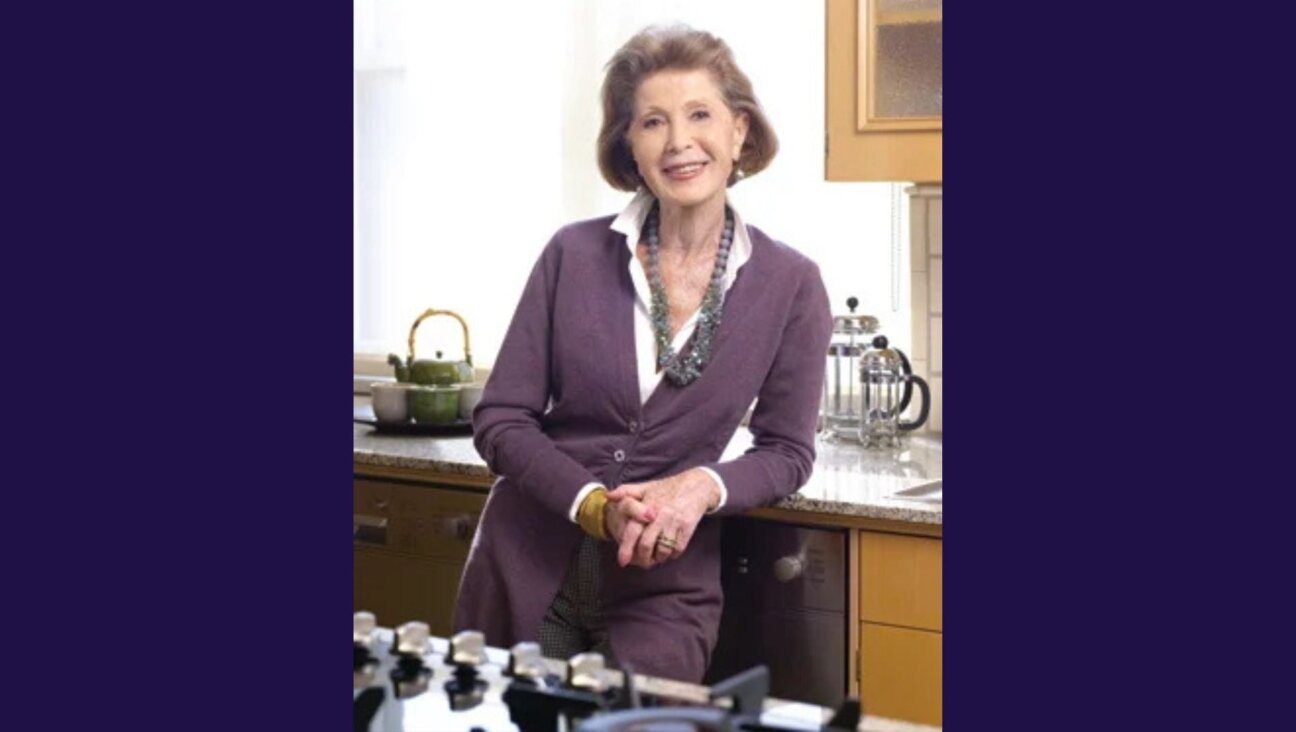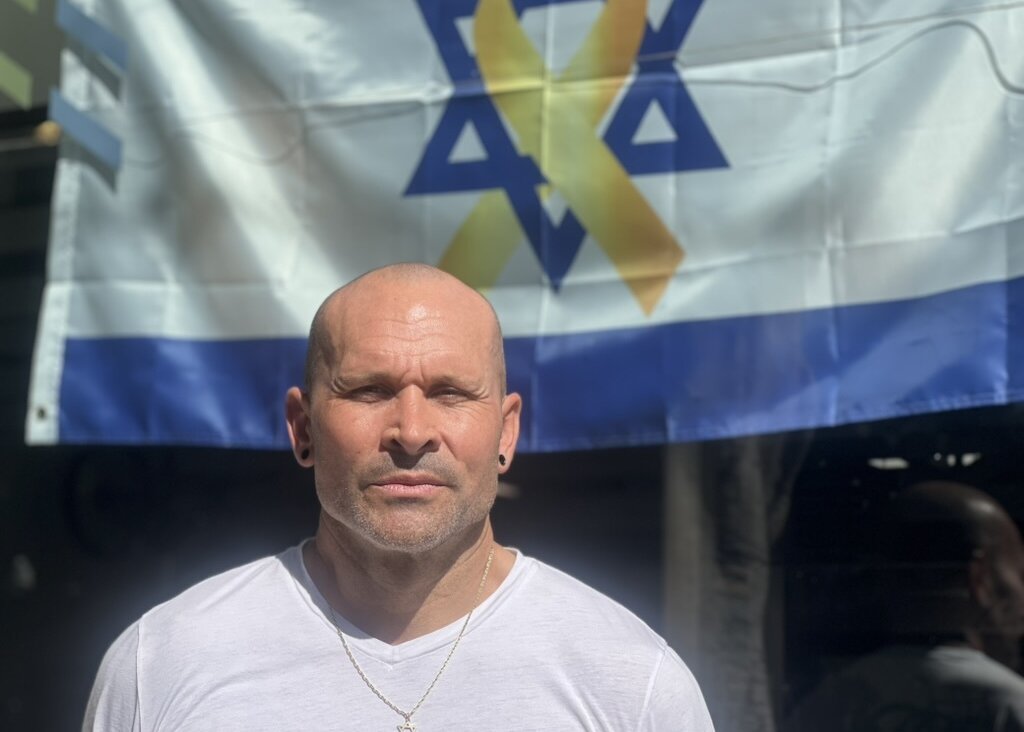Youngish, Yiddish and Staging a Revival

Graphic by Angelie Zaslavsky
Yiddish was alive and doing quite well, for a sure few hours, at a synagogue on the edge of downtown Philadelphia. Onstage, six performers — in their 20s and 30s, which constitutes young for Yiddish speakers — were speaking the centuries-old language of European Jews with ease. The jokes were flying. The music was piping.
The translations were beaming.
They were thrown, by projectors, onto two screens, one on either side of the Teller Auditorium stage at Philadelphia’s Congregation Rodeph Shalom, one of the city’s venerable Jewish institutions. Probably more than half the audience didn’t need the English wording; many of these folks had grown up speaking Yiddish or at least hearing it daily. The median age among the 140 people who had come to see “Mama’s Loshn Kugel,” whose title is a pun on the noodle dish and the Yiddish language, was solidly in the 70s.
The crowd probably would have been larger. but as it happened, June 13 saw an unusual explosion of Yiddishkeit *in Philly. At the central library, also downtown, the chorus of the local Workmen’s Circle/Arbeter Ring was giving a Yiddish concert at the same time as The Troupe — the traveling offshoot of the Folksbiene, America’s national Yiddish theater — was performing “Mama’s Loshn Kugel.” Since the language pops up only periodically, the situation was an unfortunate conflict, but as they used to say about such things on Manhattan’s Lower East Side, about the way the cookie crumbles, *azoy vert dos kitchl tsekrokhn.
“Come hear this great music and keep it alive!” touted the Workmen’s Circle Chorus flier, but across downtown Philly, The Troupe’s message was less about altruistically saving the language than mining it for its cultural treasure — and that mining means translation. The English that flashed onto the screens was a simple declaration that Yiddish, if not exactly dead, is certainly foreign to a growing number of baby-boomers entering America’s Jewish senior class — people like me: 60 years of age, able to recognize a word and a phrase, but unable to traffic in the basics of the language, let alone handle its many nuances.
I smiled during The Troupe’s performance, not just in response to the content of old Yiddish bits and songs that make up the stage revue, but also because I was comfortable in the company of the last American generation to appreciate the language in the first person. My wife, Susan, was an anomaly in the audience; Yiddish was part of her actual studies, and she learned it well at a Montreal Jewish day school in the 1950s, along with Hebrew and the requisite French and English, a daily kiddie-language immersion. While she was doing that, the Forverts was arriving at our central Pennsylvania house daily for my grandma, who talked to me in English about the news it carried. Yiddish was in my soul. But it was not in my brain.
And that’s pretty much the history of the group of actors that compose The Troupe, Folksbiene’s outreach to the hinterlands, established about five years ago. “None of us spoke Yiddish,” said Matthew Didner, now better known by his Yiddish first name, Motl. At 35, Didner is associate artistic director of Folksbiene and the eldest of The Troupe’s seven members. “My grandparents spoke Yiddish,” he said. “They didn’t teach it to my parents in Brooklyn — they used it when they didn’t want to be understood. I knew only the assorted phrases and words that have worked their way into English usage.” Didner paused a second. “Most of which are impolite.”
Didner was a professional theater artist living in Richmond, Va., and had just come back to New York in 2002, when he saw a flier for a free “instant Yiddish” class at Workmen’s Circle Manhattan headquarters on 33rd Street: “I just had such a great time at this little one-hour class,” Didner remembered. “Yiddish resonated with me.” He ended up at Columbia University, studying the language.
Surprised to learn that professional Yiddish theater still existed, he volunteered to work at a Folksbiene gala event. In fact, the Folksbiene is the only one remaining of the 15 New York Yiddish theater companies working in the early 1900s.
“That night at the gala,” he said, “I heard Zalmen Mlotek, the artistic director, talking about the vision for the future, including a touring company for outreach. A light bulb went off. I walked up to him and introduced myself. I said, ‘I heard what you said about wanting an outreach program, and I think I’m your guy.’”
Didner wrote grants for seed money, got actors involved in Yiddish-immersion programs and launched The Troupe. These days, Troupe members speak Yiddish while at work and often while socializing. (Didner met his wife, Troupe member Danielle “Elize-Rokhl” Dorter, at work.) Although cost has precluded trips beyond the East Coast, this year, The Troupe performed 33 times, at sites around New York City and also in Schenectady and Albany, in Amherst, Mass., and all over New Jersey.
They were, no doubt, a success in the Philadelphia appearance, their third in three years and the second one sponsored by Beth Ahavah, a congregation affiliated with Rodeph Shalom that reaches out to gay, lesbian and transgender Jews. The first Troupe appearance, says Donald Friedman, the Beth Ahavah member who secured local Jewish federation grants to bring both shows, had an audience ranging from teens to senior citizens.
People in the audience hummed to “Raisins and Almonds,” beautifully rendered by Dorter. They helped sing the chorus of a song about whiskey; “Nachamol!” — again! — egged on the singer, Richard “Ruvn” Kass. They smiled knowingly at “Yidl Mitn Fidl” and other songs sung by Daniella Rabbani in a tribute to a native Philadelphian, Molly Picon. They laughed heartily at skit lines like, “She died years ago; may she live to be 120.”
Not everyone was pleased. “It’s so pedestrian,” said Mildred Diamond, 89, who understood every word but not the premise behind the show, which was decidedly not meaty. “This is the kind of show they would have put on on East Broadway in the early 1900s,” she said, not meaning it as a compliment.
That seemed to be exactly what others wanted. “I feel that I would really like to make contact with something I had around me when I was young,” said Sid Perloe, 77, who is beginning to learn Yiddish with his wife, Paulette Jellinek. They were planning to attend a weeklong Yiddish program offered by the Workmen’s Circle, and were already leaving notes in Yiddish to each other. They clearly were enjoying The Troupe.
“We are part of a broader cultural movement,” Didner said of the group. “It’s great to see more people, and younger people, getting involved. There are more college students studying Yiddish now than anytime in the recent past. And as much as we bring shows to colleges and to younger audiences, we also bring them to older audiences, to audiences with Holocaust survivors. You see them react to the culture they thought was just gone. The impact is phenomenal. I can’t tell you the emotional reactions people have to it.”
Howard Shapiro is a theater critic for the Philadelphia Inquirer and also writes about travel.















